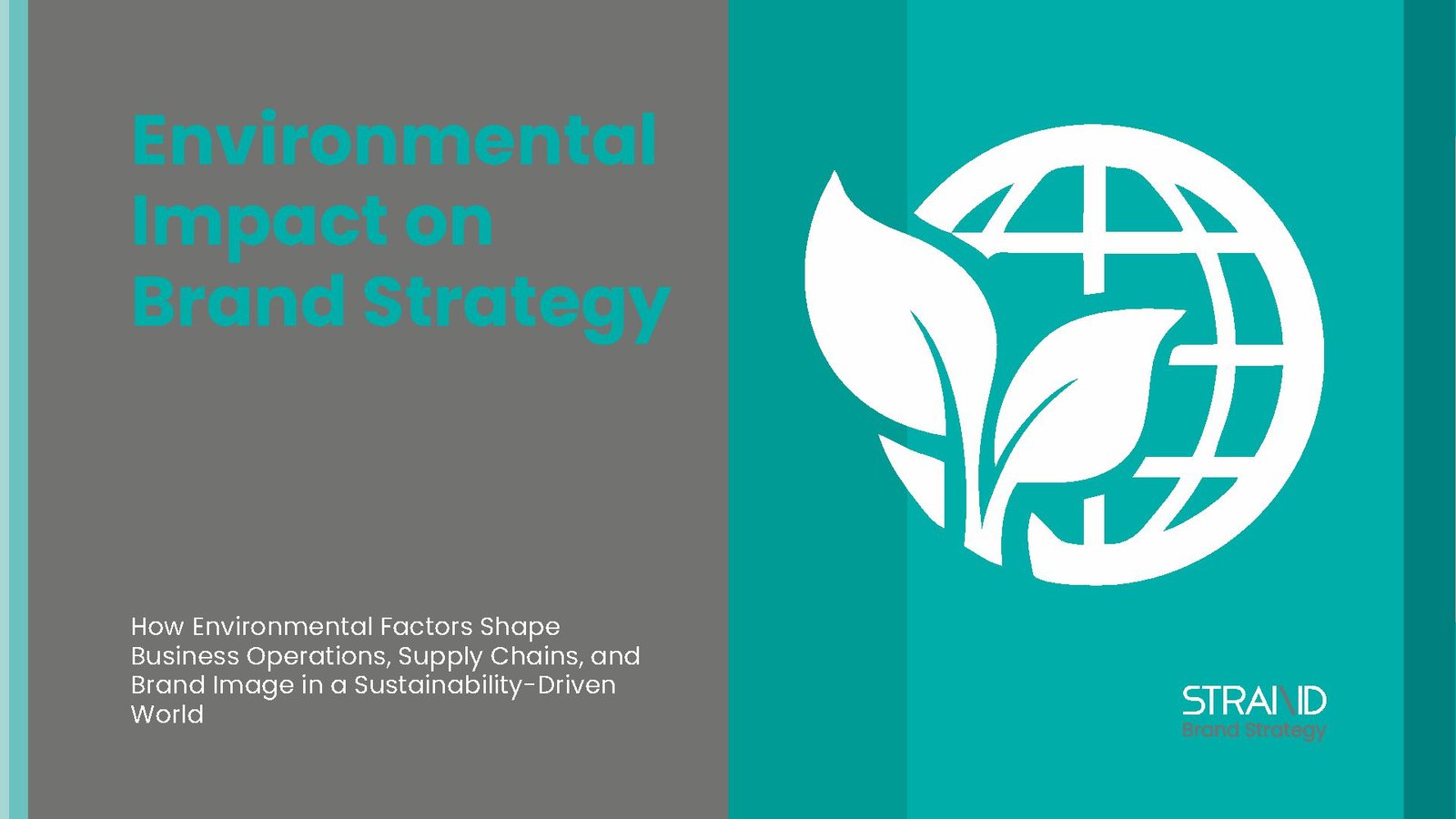Environmental Impact on Brand Strategy
8 minutes | 28 Oct 2024How Environmental Factors Shape Business Operations, Supply Chains, and Brand Image in a Sustainability-Driven World
In an era of increasing environmental awareness and growing concern over climate change, businesses face new challenges and opportunities. Environmental factors such as sustainability, regulatory pressures, climate risks, and resource availability are reshaping the way companies operate and interact with the world. These considerations are no longer just about corporate social responsibility but are essential to long-term business success. Companies across industries are reevaluating their operations to minimize their environmental impact, comply with evolving regulations, and meet the demands of eco-conscious consumers.
In this article, we’ll explore how environmental regulations, climate change, sustainability concerns, and resource management are affecting business strategies, supply chains, and brand image.
The Role of Environmental Regulations in Business Strategy
Environmental regulations refer to laws and policies designed to protect the environment by controlling pollution, managing natural resources, and promoting sustainability. These regulations are enforced by governments and international bodies to ensure businesses operate in ways that reduce harm to the planet.
As the global focus on climate change intensifies, governments are introducing stricter regulations to limit carbon emissions, reduce waste, and protect natural resources. The European Union’s Green Deal, the U.S. Environmental Protection Agency’s Clean Air Act, and the Paris Agreement are just a few examples of regulatory initiatives that aim to mitigate environmental impact.
In addition to governmental regulations, voluntary standards and certifications—such as LEED (Leadership in Energy and Environmental Design) for sustainable buildings and ISO 14001 for environmental management systems—are gaining prominence. These standards encourage businesses to adopt more sustainable practices, often enhancing their reputation and market competitiveness.
Environmental regulations have a profound impact on business operations, influencing everything from production methods to supply chain management. Companies must ensure compliance with these regulations to avoid legal penalties, fines, and reputational damage. For industries such as manufacturing, energy, and transportation, compliance often requires significant investments in cleaner technologies, waste reduction processes, and renewable energy sources.
In regions with stringent environmental regulations, companies that adopt sustainable practices can benefit from government incentives, such as tax credits and subsidies for green investments. Additionally, compliance can open up new market opportunities, particularly in regions where consumers prioritize eco-friendly products and services.
Automobile manufacturers like Tesla and Toyota have adapted to environmental regulations by investing heavily in electric vehicles (EVs) and hybrid technology. The push for cleaner transportation solutions aligns with global efforts to reduce carbon emissions, positioning these companies as leaders in the transition to sustainable mobility.
In contrast, companies that fail to comply with environmental regulations can face significant consequences. For example, Volkswagen’s 2015 emissions scandal, in which the company was found to have cheated on emissions tests, resulted in billions of dollars in fines, damaged brand reputation, and a loss of consumer trust.
The Impact of Climate Change on Business Strategy
Climate change is one of the most significant environmental challenges of our time, posing risks to businesses through extreme weather events, changing weather patterns, and rising sea levels. These changes can disrupt supply chains, damage infrastructure, and increase operational costs. At the same time, climate change creates new opportunities for businesses that invest in sustainable solutions and innovations.
- Physical Risks:
Extreme weather events such as hurricanes, floods, droughts, and wildfires are becoming more frequent and intense due to climate change. These events can damage production facilities, disrupt logistics networks, and impact the availability of raw materials. Companies with global supply chains are particularly vulnerable to these disruptions. - Transitional Risks:
As governments and consumers push for a low-carbon economy, businesses face transitional risks associated with shifting regulations, technological advancements, and changing market demands. For example, energy-intensive industries such as oil, gas, and manufacturing are under pressure to transition to renewable energy sources, which may require costly investments in new technologies. - Consumer Expectations:
Climate-conscious consumers are increasingly demanding that businesses take responsibility for their environmental impact. Brands that ignore these expectations risk losing market share to competitors that prioritize sustainability. Companies in sectors such as fashion, food, and retail are particularly affected, as consumers seek eco-friendly products, ethical sourcing, and transparent supply chains.
While climate change poses significant risks, it also presents opportunities for businesses that invest in climate resilience and sustainability. By adopting renewable energy, reducing emissions, and enhancing resource efficiency, companies can lower costs, improve operational stability, and gain a competitive edge.
Businesses that prioritize sustainability are also better positioned to attract environmentally conscious investors and consumers. The growing trend toward Environmental, Social, and Governance (ESG) investing reflects the increasing importance of sustainability in business strategy. Companies that perform well on ESG metrics tend to enjoy stronger investor confidence and higher market valuations.
Climate change affects a wide range of stakeholders, including employees, customers, investors, and communities. Employees are increasingly seeking to work for companies that align with their values, including a commitment to addressing climate change. Similarly, customers are more likely to support brands that demonstrate environmental responsibility.
Investors are also paying closer attention to how companies manage climate-related risks. The Task Force on Climate-related Financial Disclosures (TCFD) has set guidelines for companies to report on their exposure to climate risks, prompting greater transparency and accountability in how businesses plan for the future.
Patagonia, an outdoor apparel company, is a leading example of a business that has embraced climate-conscious practices. The company has long championed sustainability, using recycled materials, minimizing waste, and supporting environmental activism. Patagonia’s commitment to environmental stewardship has earned it a loyal customer base and strong brand identity.
On the other hand, energy companies like ExxonMobil face significant challenges as climate change drives a global transition away from fossil fuels. While some oil and gas companies are investing in renewable energy, those that fail to adapt to the changing energy landscape risk losing market share and facing regulatory penalties.
Sustainability and Resource Availability in Business Strategy
Sustainability refers to the ability of businesses to operate in ways that meet present needs without compromising the ability of future generations to meet their own. This involves managing natural resources efficiently, reducing waste, and minimizing environmental impact. In recent years, sustainability has evolved from a niche concern to a mainstream business imperative.
- Sustainable Resource Management:
Businesses that rely on natural resources, such as water, minerals, and agricultural products, must consider the long-term availability of these resources. Climate change, population growth, and environmental degradation are all contributing to resource scarcity, forcing companies to rethink how they manage inputs.
For example, companies in the food and beverage industry are focusing on sustainable sourcing practices to ensure the long-term availability of key ingredients. Many businesses are also exploring circular economy models, which emphasize recycling, reuse, and waste reduction to extend the lifecycle of products and materials. - Renewable Energy and Efficiency:
The shift toward renewable energy is a key component of sustainable business practices. Solar, wind, and hydropower offer clean, reliable alternatives to fossil fuels, reducing greenhouse gas emissions and lowering energy costs. Companies that invest in renewable energy not only reduce their carbon footprint but also protect themselves from volatility in traditional energy markets.
Energy efficiency is another critical aspect of sustainability. By optimizing processes, improving insulation, and adopting energy-saving technologies, businesses can reduce their overall energy consumption and lower operational costs. - Sustainable Packaging and Waste Reduction:
The rise of eco-conscious consumers has spurred demand for sustainable packaging solutions. Businesses are adopting biodegradable materials, reducing plastic use, and investing in recyclable or reusable packaging. These initiatives not only reduce environmental impact but also resonate with consumers who prioritize eco-friendly products.
Unilever’s Sustainable Living Plan is a widely cited example of a successful corporate sustainability initiative. The company has set ambitious targets for reducing its environmental footprint, including cutting greenhouse gas emissions, improving water usage, and promoting sustainable sourcing of raw materials. By integrating sustainability into its core business strategy, Unilever has strengthened its brand and achieved significant cost savings.
Similarly, IKEA has made sustainability a cornerstone of its business model. The company has committed to sourcing 100% renewable energy, reducing waste, and designing products with a circular economy in mind. IKEA’s sustainability efforts have not only enhanced its brand image but also improved its operational efficiency and long-term profitability.
The Future of Business in an Environmentally Conscious World
Environmental factors—such as regulations, climate change, sustainability concerns, and resource availability—are reshaping the way businesses operate. Companies that proactively address these challenges by investing in sustainable practices, renewable energy, and climate resilience are better positioned for long-term success. At the same time, those that fail to adapt to the evolving environmental landscape risk regulatory penalties, reputational damage, and lost market opportunities.
The future belongs to businesses that embrace sustainability as a core component of their strategy. By aligning operations with environmental goals, companies can protect their brand, improve operational efficiency, and contribute to a more sustainable world.

